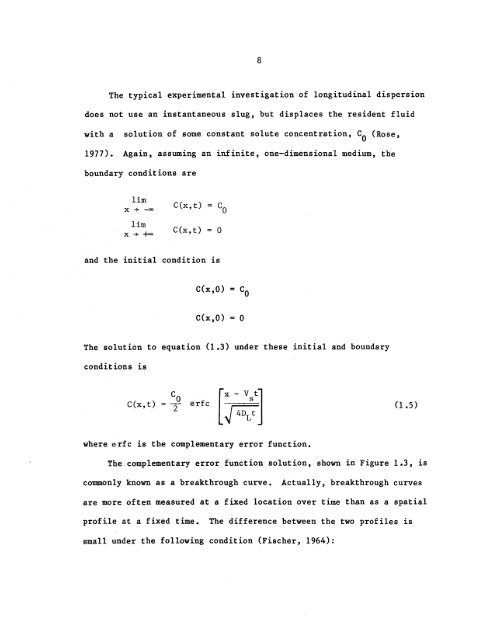longitudinal dispersion in nonuniform isotropic porous media
longitudinal dispersion in nonuniform isotropic porous media
longitudinal dispersion in nonuniform isotropic porous media
You also want an ePaper? Increase the reach of your titles
YUMPU automatically turns print PDFs into web optimized ePapers that Google loves.
8<br />
The typical experimental <strong>in</strong>vestigation of <strong>longitud<strong>in</strong>al</strong> <strong>dispersion</strong><br />
does not use an <strong>in</strong>stantaneous slug, but displaces the resident fluid<br />
with a solution of some constant solute concentration, Co (Rose,<br />
1977). Aga<strong>in</strong>, assum<strong>in</strong>g an <strong>in</strong>f<strong>in</strong>ite, one-dimensional medium, the<br />
boundary conditions are<br />
lim<br />
x -+ _00<br />
lim<br />
x -+ +00<br />
C(x,t)<br />
C(x,t) o<br />
and the <strong>in</strong>itial condition is<br />
C(x,O) = Co<br />
C(x,O) = °<br />
The solution to equation (1.3) under these <strong>in</strong>itial and boundary<br />
conditions is<br />
C(x,t) erfc (1.5)<br />
where erfc is the complementary error function.<br />
The complementary error function solution, shown <strong>in</strong> Figure 1.3, is<br />
commonly known as a breakthrough curve. Actually, breakthrough curves<br />
are more often measured at a fixed location over time than as a spatial<br />
profile at a fixed time. The difference between the two profiles is<br />
small under the follow<strong>in</strong>g condition (Fischer, 1964):

















